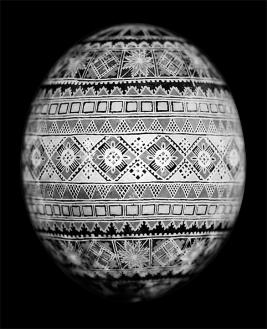Matthew Cherry
Pysanka

Pysanka is a traditional Ukrainian Easter egg decorated using a wax-resist ‘batik’ method. The word pysanka comes from the verb pysaty, “to write,” as the designs are not painted on, but written with beeswax. Many of the designs used to decorate pysanky can be directly traced back to the Bronze Age, 5000 years ago, when the Trypillian culture prospered in Ukraine. The Hutsuls, Ukrainians who live in the Carpathian Mountains of western Ukraine, believe that the fate of the world depends upon the pysanka. As long as the egg decorating custom continues, the world (and those in it) will exist. If, for any reason, this custom is abandoned, evil, in the shape of a horrible serpent who is forever chained to a cliff, will overrun the world. Each year the serpent sends out his minions to see how many pysanky have been created. If the number is low the serpent's chains are loosened and he is free to wander the earth causing havoc and destruction. If, on the other hand, the number of pysanky has increased, the chains are tightened and good triumphs over evil for yet another year. To give a pysanka is to give a symbolic gift of life, which is why the egg must remain entire. Each of the designs and colors on the pysanka has a deep, symbolic meaning. The star, “Zorya”, symbolizes life, growth and good fortune.
The serpent in this pre-Christian legend is reminiscent of the story of Adam & Eve and ultimately man's struggle against evil. The Pysanky Series follows this path and shows the Pysanky as a representation of the divine spirit in man, through which good may triumph over evil. The real Pysanky which must be created to ward of evil is the goodness that lives within us. As long as we continue to raise future generations that embrace light, the serpent will be at bay, however, when we allow our children to turn away from the light (as under the dark oppression of communism) then the serpent will run free. The story is told over a series of six images. The first is photograph of the Pysanka itself. The second is of several human sperms, each one containing a pysanka representing the soul of man. The third image will be a representation of Adam, a nude male holding a pysanka over himself in place of a fig leaf. The fourth is Eve, also nude and holding a pysanka in place of the fig leaf and with a crown of flowers. The fifth in the series is a photograph of pregnant woman. She is shot seated from her thigh to her breasts and imposed, as if contained within, her belly is a pysanka. The sixth image will be an infant, cradled in a cracked pysanka. The child in the pysanka represents the struggle for the future of Ukraine...
The serpent in this pre-Christian legend is reminiscent of the story of Adam & Eve and ultimately man's struggle against evil. The Pysanky Series follows this path and shows the Pysanky as a representation of the divine spirit in man, through which good may triumph over evil. The real Pysanky which must be created to ward of evil is the goodness that lives within us. As long as we continue to raise future generations that embrace light, the serpent will be at bay, however, when we allow our children to turn away from the light (as under the dark oppression of communism) then the serpent will run free. The story is told over a series of six images. The first is photograph of the Pysanka itself. The second is of several human sperms, each one containing a pysanka representing the soul of man. The third image will be a representation of Adam, a nude male holding a pysanka over himself in place of a fig leaf. The fourth is Eve, also nude and holding a pysanka in place of the fig leaf and with a crown of flowers. The fifth in the series is a photograph of pregnant woman. She is shot seated from her thigh to her breasts and imposed, as if contained within, her belly is a pysanka. The sixth image will be an infant, cradled in a cracked pysanka. The child in the pysanka represents the struggle for the future of Ukraine...
Artist Biography
First educated as a jazz bassist at the Greater Hartford Academy of the Performing arts, Hartford Camerata Conservatory of Music and at Berklee College of Music, Cherry had to stop performing due to a degenerative bone disorder. Since that time, Cherry has turned his creativity toward still and motion photography and has been creating compelling images for over twenty years. Always fascinated by form and light, he combines high production values with his cinematic storytelling to evoke an emotional response to his imagery. A photographer and cinematographer, Cherry has worked in independent films and corporate video as well as commercial photography. Cherry draws inspiration from a wide range of artistic sources, most notably Italian and French cinema, American Film Noir and American Jazz artists of the 40s and 50s.







